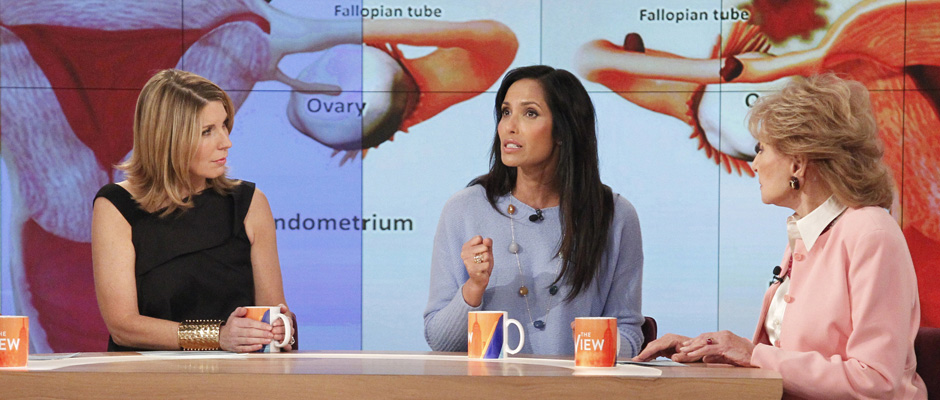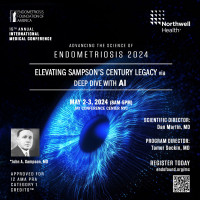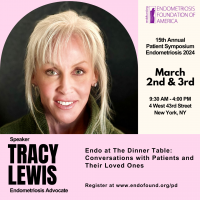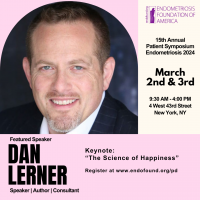
The View guest co-host Padma Lakshmi told her personal story about being diagnosed with Endometriosis on the Friday, February 20th, 2015 episode of The View. This prognosis is one that leads a lot of women to get a hysterectomy, but that course of treatment is not always necessary. However, it is a path often chosen due to a lack of information which is why Padma has created the Endometriosis Foundation of America to help inform women about this disorder. There is no cure but there are ways that the symptoms can be managed. It is also important that women get checked for this as they may be asymptomatic for various reasons. Check out more information on Endometriosis below such as symptoms, causes and treatments.
Endometriosis:
- A highly damaging disease of the female reproductive system
- Occurs when endometrial tissue grows in areas outside of the uterus
- Approximately 1 out of every 10 women of childbearing age live with endometriosis in the United States
- 176 million women worldwide live with endometriosis
What it is:
Endometriosis is a disease of the female reproductive system that affects approximately 1 in 10 women worldwide. Endometriosis occurs when the endometrial cells, or uterine lining cells, exist outside of the uterus. They can be found on the outside of the uterus, fallopian tubes or ovaries, or on surrounding organs in the abdomen such as the intestines, bladder or rectum. Each month, the endometrial cells act as they should, by swelling and thickening, then bleeding. However, since they are outside of the uterus, this leads to endometrial lesions, which worsen over time and can cause severe pain.
Symptoms
Symptoms of endometriosis vary greatly from woman to woman. They might include:
- Chronic or intermittent pelvic pain
- “Killer Cramps”
- Cramps during a period are normal. They may be uncomfortable but over the counter pain meds allow a woman to go about her day. “Killer Cramps” are different. They are severe cramps that impact a woman’s ability to participate in daily activities. She may have to stay home from school, work, or other activities.
- Long and heavy periods
- Nausea and/or vomiting
- Diarrhea and/or constipation
- Chronic lower back pain
- Headaches
- Pain associated with sexual activities
- Infertility or pregnancy loss
For many women, symptoms will begin around the time of her first period. Some women with endometriosis will experience no symptoms of the disease.
What Causes Endometriosis?
Currently, there is no consensus in the medical and scientific communities on the cause of endometriosis. Many biological aspects are likely involved, including genetics, stem cells, and immune factors. Endometriosis has a known genetic component, meaning that a girl whose mother has the disease is 5 to 7 times more likely to have endometriosis herself. Endometriosis is also associated with other immune disorders.
Diagnosing Endometriosis
If you suspect you or someone you know might have endometriosis, speak to a gynecologist about your symptoms. Most diagnoses are made through the clinical presentation of several of the symptoms described above. The only method of confirming a diagnosis is through a biopsy of the tissue, which would be conducted if you and your doctor determined that surgery was required for treatment.
Endometriosis is often mistaken for other diseases, resulting in a ten-year average delay in diagnosis. Seeing a gynecologist is the best way to ensure that endometriosis will be properly diagnosed.
Treatment and Pain Management
There are several options for managing the symptoms of endometriosis, including:
- Hormonal birth control
- Other hormonal therapies
- Diet/exercise
- Alternative therapies, such as acupuncture, massage, or homeopathic remedies
These options effectively manage pain for many, but not all, patients. Currently, the best-known treatment for endometriosis is a procedure called “laparoscopic excision surgery,” in which a surgeon removes the endometrial lesions through tiny incisions in the abdomen. Other types of laparoscopic surgery exist as well, and it is advised to have multiple conversations with your surgeon to determine that he/she is best suited to conduct the surgery.
For more information go to ENDOFOUND.ORG
Story:
http://abc.go.com/shows/the-view/news/view-news/20150220-padma-lakshmi-on-why-women-need-to-know-about-endometriosis









